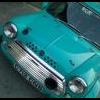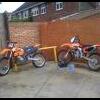Charge Cooler Info/help
#31

Posted 31 May 2010 - 08:44 AM
#32

Posted 31 May 2010 - 08:46 AM
have you any proof or supporting evidence of this graham , id be really interested to see it .Personally I can't see that charge cooler working efficiently. Optimum ACT's (Air Charge Temperature) is 39 degrees. Don’t be fooled that the low the ACT’s the better performance is obtained...
graham ,just to be sure ,are you saying you can prove that any air temp below 39 degrees c is bad for power ?
Temps below 39 degrees will be 'ok', but to get the best power you need to stay as close to 39 degrees as possible.
(whoops sorry phil didnt see that youd asked allready ,were not getting on your case graham ,just interested in new data ..)
Edited by ivanhoew, 31 May 2010 - 08:48 AM.
#33

Posted 31 May 2010 - 09:14 AM
Family history is:
GRSmotorsport has a wealth of experience in heat transfer.
My great grandfather invented the Clayton-Still wire bound tube radiator; this was patented and licensed for manufacture for use on the London buses in the 1920’s.
My grandfather wrote a book called “Some Factors Affecting the Design of Heat Transfer Apparatus”. He also worked for Rolls Royce in the development team designing the radiators and oil coolers for the Spitfire during the 2nd World War.
My father who brought me up around vintage & post war cars worked for Normal Air Garrett, designing cabin control pressure systems for aircraft. He also helped design the Re-breathing diving system for the James Bond film ‘For Your Eyes Only’.
I was offered a job with the Williams Grand Prix team in 1996 in their fabrication shop, but unfortunately due to my daughter being born prematurely I was unable to take the position.
10 years ago I set up my company.
Last year I worked on 2 other projects with 2 impendent tuning companies who required 39 degrees as their optimum ACT’s. Some scientist boffen has worked out that 39 degrees is the best temp to have.
Construct of cores ie glued or vacuum brazed is important to know and how the air enters the core through the end tanks and the way it moves through the core are very important, get these parameters right and you get the ideal cooling/temps required.
(Mods, please feel free to remove any parts of this contents you are now happy with)
#34

Posted 31 May 2010 - 09:20 AM
Some scientist boffen has worked out that 39 degrees is the best temp to have.
good post graham ,thanks for the cv ,very impressive . do you happen to know if the boffin is published anywhere ?
#35

Posted 31 May 2010 - 09:48 AM
Leave it with me, I'll do some digging and report back! I have a friend of mine did is doctorate at Bath university on making his lectures (friend of our family!) Type 51 Bugatti supercharger more efficient. He also said 39 degrees was the best temp to have, I’ll have a word with him this week…good post graham ,thanks for the cv ,very impressive . do you happen to know if the boffin is published anywhere ?Some scientist boffen has worked out that 39 degrees is the best temp to have.
#36

Posted 31 May 2010 - 10:12 AM
excellent thank you ,incidentally ,do you know geriant owen ?Leave it with me, I'll do some digging and report back! I have a friend of mine did is doctorate at Bath university on making his lectures (friend of our family!) Type 51 Bugatti supercharger more efficient. He also said 39 degrees was the best temp to have, I’ll have a word with him this week…good post graham ,thanks for the cv ,very impressive . do you happen to know if the boffin is published anywhere ?Some scientist boffen has worked out that 39 degrees is the best temp to have.
#37

Posted 31 May 2010 - 11:39 AM
excellent thank you ,incidentally ,do you know geriant owen ?Leave it with me, I'll do some digging and report back! I have a friend of mine did is doctorate at Bath university on making his lectures (friend of our family!) Type 51 Bugatti supercharger more efficient. He also said 39 degrees was the best temp to have, I’ll have a word with him this week…good post graham ,thanks for the cv ,very impressive . do you happen to know if the boffin is published anywhere ?Some scientist boffen has worked out that 39 degrees is the best temp to have.
Yes my father does. Gerinats father owns Babs the car that was trying for the land speed record in Wales in the 30's...
#38

Posted 31 May 2010 - 12:28 PM
#39

Posted 31 May 2010 - 08:50 PM
#40

Posted 31 May 2010 - 08:58 PM
I have kept an eye on charge cooler temps (only on the outside casting) & the temp has never gone over 55c.
Having a water cooler as vmax (plumbed of the engine im asumming). water temp at 88c dose not add up to me?
I might be getting it all wrong?
JOE
Is your charge cooler using its own water supply, or using the water from the engines radiator?
I havnt got a charge cooler as i dont think its needed. I just didnt make myself clear. im asuming that it runs of the engine rad but not sure. No one seems to say what temp charger is to start with that was all.
I am running exhaust wrap on exhaust manifold & inlet manifold to try & keep things as cool as possible
#41

Posted 31 May 2010 - 09:07 PM
I have kept an eye on charge cooler temps (only on the outside casting) & the temp has never gone over 55c.
Having a water cooler as vmax (plumbed of the engine im asumming). water temp at 88c dose not add up to me?
I might be getting it all wrong?
JOE
Is your charge cooler using its own water supply, or using the water from the engines radiator?
I havnt got a charge cooler as i dont think its needed. I just didnt make myself clear. im asuming that it runs of the engine rad but not sure. No one seems to say what temp charger is to start with that was all.
I am running exhaust wrap on exhaust manifold & inlet manifold to try & keep things as cool as possible
A charge cooler should have its own water system, totally independent from the engine. The system will have its own pre-rad, water pump, water reservoir, hose’s etc. Using the water from the engine won’t help at all. Having said that the large turbo Escort Cosworth used a charge cooler as standard with an intercooler using the water from the engine!! But this was to do with emissions so I was told!.
Having a water jacket on the top of the charger as shown in the picture above is on the wrong side, there’s no heat there, its underneath where you need the cooling, problem is there isn’t any room!! As long as you are running under 10psi of boost a charge cooler or intercooler isn’t required as stated by David Vizard
Edited by Grahamxx, 31 May 2010 - 09:26 PM.
#42

Posted 02 June 2010 - 09:14 PM
thanks lee
#43

Posted 03 June 2010 - 11:24 PM
#44

Posted 04 June 2010 - 05:48 AM
Ok had an email from my friend who did his dissertation on making a supercharger more efficient, he’s going to give me his project on a memory stick for me to read through, but said a lot of his studies were done using tech books based on forced induction there is states the best ACT’s to use is 39 degrees C, however his theory is ‘using the optimum temperature to maximize air density and saturation of fuel droplets. This would give you the biggest bang for a given swept volume’. Soon as I have more info I’ll pass it on….
great ,thanks for taking the time graham ,,this would seem to suggest that the optimium temp would vary depending on the fuel delivery methods ..eg a finer droplet size from a su ,would have a differet optimum temp to a larger size from a weber ...also , if fuel is injected after the charger ,then possibly a much lower air temp would create greater v e ,without fuel drop out occuring .
another concept to consider ,is , operating range of the engine ,and port speed through the induction system ,higher the rpm band used ,the less the dropout problem would create a need for high inlet temps ,and the higher the port speed ...ditto .
personally i am of the opinion that the coldest that is realistically obtainable ,the better ,but id be very happy to learn that im wrong if it proves to be so
regards
robert
#45

Posted 18 January 2011 - 01:16 PM
1 user(s) are reading this topic
0 members, 1 guests, 0 anonymous users


















